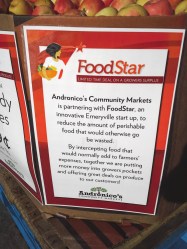 On the surface, it’s a common display. A bin of apples with a sale sign greets customers as they enter the grocery store. Behind the scenes, however, it’s unchartered territory. Those apples are too small to be considered sufficient quality, or grade, for retail grocery stores. They were destined to be juice, cattle feed, or maybe even landfill waste until a few crafty folks and a bold supermarket decided to break the grade barrier.
On the surface, it’s a common display. A bin of apples with a sale sign greets customers as they enter the grocery store. Behind the scenes, however, it’s unchartered territory. Those apples are too small to be considered sufficient quality, or grade, for retail grocery stores. They were destined to be juice, cattle feed, or maybe even landfill waste until a few crafty folks and a bold supermarket decided to break the grade barrier.
Meet FoodStar and its courageous partner Andronico’s Community Market, a small Northern California grocery chain. Together, they are taking a chance on the idea that maybe we consumers aren’t as picky as most supermarkets seem to think we are. Maybe we’d be willing to buy a slightly smaller apple that only has 37 percent red coverage instead of the requisite 40 percent needed to qualify as the “fancy” grade that stores usually buy (yes, it’s actually measured). Maybe we consumers would even consider it a score to get a bag of Pink Lady apples for just 69 cents per pound.
Last month, the Natural Resources Defense Council released a survey of farmers that indicated sometimes as much as 30 percent of fresh produce does not make it off the farm. This is a waste of nutrition in addition to all of the money and resources that went into growing that food. One key driver that causes fruits and veggies to be left on the field or fed to cattle is that they are not cosmetically perfect enough to meet the high standards that grocery stores mandate. Many retailers insist that fruits and veggies meet exact cosmetic criteria, including specifications for size, color, weight, and blemish level — leading to culling and incorporating waste as part of doing business. Waste, however, is not cheap. The U.S. Department of Agriculture estimates that supermarkets lose $15 billion [PDF] each year in fruit and vegetable losses alone.
Andronico’s Jonathan Packman said of the project, “We’re proud to be working with FoodStar to launch this initiative, since it simultaneously addresses several problems in the food supply chain. FoodStar presented Andronico’s with an opportunity to partner on this concept to divert food from the waste stream and create a viable, marketable product.”
“This is very groundbreaking stuff, because a retailer has broken the grade barrier and passed along the significant cost savings to the consumer,” says Ron Clark, coordinator for the Farm Direct aspect of FoodStar and former director of the California Farm to Family program, which distributed 120 million pounds of rescued produce to food banks in 2011 alone. By breaking the “grade barrier,” he is describing the highly specified standard of quality and aesthetics that most supermarkets would not dare to go below for fear a customer will be disappointed with their produce offerings. As Packman explains, “While selling from the same open bin of apples that the grower sends to us may seem simple, it actually represents a significant departure from how things are normally done in the grocery business.”
These were perfectly good apples we’re talking about, just with a bit of a Goldilocks problem. They were one quality level below what grocery stores traditionally buy. They were also too small to be used as “peelers,” which eventually become apple pie, applesauce, and McDonald’s Happy Meal snacks. In fact, they were actually on their way to becoming caramel apples for Halloween, but were pulled off the sorting line because orders for caramel apples were not as large as originally thought. Given this predicament, the apples would normally have been sent to the juice market if there were demand, or to cattle feed or a landfill if not. By intercepting them, FoodStar and Andronico’s are ensuring that these apples are going to their highest and best use possible — feeding people fresh food, affordably.
There are a few key aspects to this plan that make it work. First, the featured product changes, which allows surplus product in the supply chain to be absorbed in the way it happens — spontaneously. One week it’s Pink Ladies, the next week Granny Smiths. Second, decisions are made to keep the cost down, such as selling the apples out of large bins instead of the shipper paying to box them and the grocery store paying to unpack them. And finally, savings are passed on to the consumer, effectively warning the consumer that they might have to be slightly more tolerant of imperfections they wouldn’t normally see on the shelf. By carrying the FoodStar brand and locating the product in a different place, Andronico’s avoids the risk that consumers will judge their whole produce offering on this product.
Though they’re only a few weeks into the program, Packman reports that “so far, it’s going really well; we have sold over two tons of apples already, while actually improving our overall produce sales.” Everyone wins in this scenario. For Andronico’s, it’s a way to bring in traffic and offer their customers a good deal. FoodStar, who sources the product, is able to provide good value with products that would otherwise go to lower uses or waste. The supplier is able to sell the apples at a better price. And for us consumers, we score a bag of apples for half the normal cost.
Apple pie, anyone?




